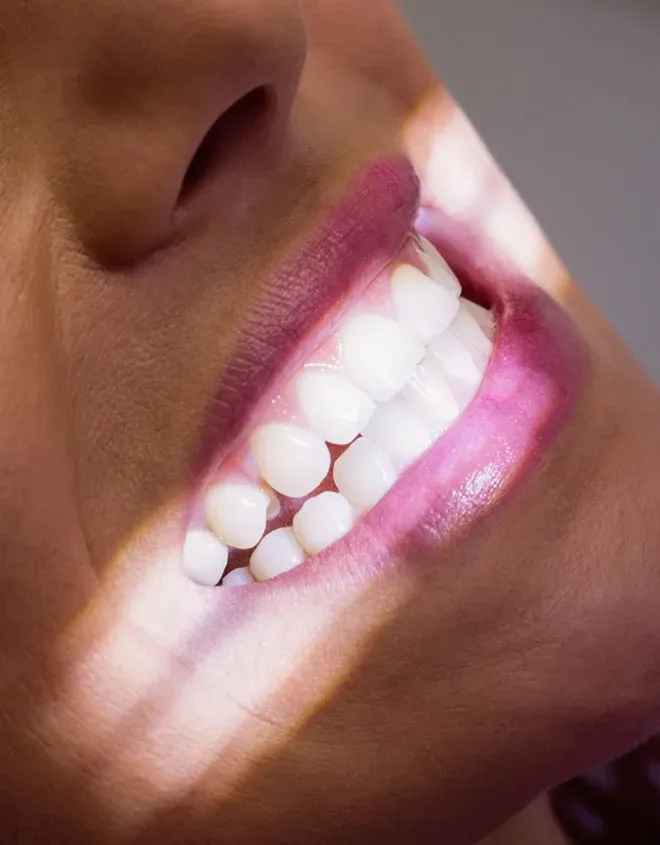Cosmetic Dentistry
Dental Bonding: What is Teeth Bonding & What to Expect

by Dr. Kang
18 March 2025

Many people want a simple way to fix small cosmetic issues with their teeth. Whether it’s a chip, a small gap, or discoloration, these imperfections can make someone feel self-conscious about their smile. Some dental treatments require multiple visits and permanent alterations to the teeth, which may not be ideal for everyone.
Dental bonding is an alternative that provides fast results with minimal changes to the natural tooth. It is a painless procedure that does not require extensive drilling or reshaping. Unlike crowns or veneers, dental bonding is non-invasive and can often be done in one visit.
This guide explains what dental bonding is, how the procedure works, and what to expect before and after treatment.

What Is Dental Bonding?
Dental bonding is a cosmetic treatment used to improve the appearance of teeth. It is commonly recommended for patients who have minor imperfections that do not require extensive procedures. The process is quick, painless, and non-invasive, making it a preferred option for those looking to enhance their smile without undergoing major dental work.
What Problems Can Dental Bonding Fix?
Dental bonding is used to address various cosmetic and functional concerns. Patients with small gaps between their teeth, minor chips, or uneven edges often benefit from this treatment. The resin material effectively conceals discoloration, making it a solution for stains that do not respond to whitening.
For individuals experiencing gum recession, bonding can cover exposed roots and reduce tooth sensitivity. While bonding is not as strong as other restorative treatments, it provides an easy and effective fix for many minor dental issues.
How Dental Bonding Works
Dental bonding uses a composite resin material that matches the natural color of the teeth. The material is applied to the tooth, shaped to the desired look, and then hardened using a special curing light. Once the resin sets, the tooth is polished to blend with the surrounding teeth.
Unlike other cosmetic treatments, dental bonding does not require significant tooth reshaping. The natural enamel remains intact, making the procedure a conservative and reversible option.

Who Is a Good Candidate for Dental Bonding?
Dental bonding is not suitable for everyone. It works best for patients with healthy teeth and gums who are looking for minor cosmetic improvements. The material is not as durable as other options like crowns or veneers, so it is not ideal for restoring large areas of damage.
Mild to Moderate Cosmetic Issues
Bonding is a great option for those with small chips, minor gaps, or slight discoloration. It is a simple way to improve a smile without making permanent changes to the natural teeth. However, for major structural concerns, other treatments may be more appropriate.
Healthy Teeth and Gums
Since bonding does not strengthen teeth, it is important that the underlying tooth structure is healthy. Patients with untreated cavities, gum disease, or other dental issues should address those concerns before considering bonding. The procedure relies on a strong foundation to ensure long-term results.
Commitment to Maintenance
Bonding requires proper care to maintain its appearance. The material is prone to staining and can chip if not handled carefully. Patients who grind their teeth or frequently consume dark-colored foods and drinks should be mindful of how their habits affect the longevity of bonded teeth.
The Dental Bonding Process
The dental bonding procedure is straightforward and usually completed in one visit. There is no need for anesthesia unless the bonding is being used to fill a cavity.
Step 1: Preparing the Tooth
Before applying the resin, the dentist will clean the tooth thoroughly to remove any plaque or debris. The surface is then slightly roughened with a conditioning liquid to help the resin adhere better.
Step 2: Applying the Composite Resin
A tooth-colored resin is applied in small amounts and shaped to match the natural contours of the tooth. The dentist carefully sculpts the material to blend with the surrounding teeth, ensuring a natural look.
Step 3: Hardening the Material
A special curing light is used to harden the resin. This step is done in layers, allowing the material to set properly and maintain its durability.
Step 4: Shaping and Polishing
Once hardened, the bonded tooth is further refined. The dentist smooths out any rough edges and polishes the surface to match the sheen of the surrounding teeth. This final step ensures the bonding looks natural and feels comfortable in the mouth.
How Long Does Dental Bonding Last?
Dental bonding is not permanent, but with proper care, it can last for several years. The longevity of bonding depends on the location of the bonded tooth and the patient’s daily habits.
Average Lifespan of Bonded Teeth
Bonding typically lasts between 3 to 10 years before needing repairs or replacement. Teeth that experience less pressure, such as front teeth, tend to hold up longer than molars, which endure more force from chewing.
Factors That Affect Durability
- Oral hygiene – Brushing and flossing regularly helps maintain the integrity of bonded teeth.
- Diet – Limiting foods and drinks that stain, such as coffee, tea, and red wine, can help bonding last longer.
- Chewing habits – Avoiding hard foods and not using teeth to open packaging prevents unnecessary chipping.
- Teeth grinding – A nightguard can help protect bonded teeth for those who grind or clench their teeth.
Caring for Bonded Teeth
Proper care ensures that bonded teeth remain in good condition for as long as possible. The material is durable, but not as strong as natural enamel, so extra precautions should be taken.
Brushing and Flossing
Using a soft-bristled toothbrush and non-abrasive toothpaste helps prevent scratches on the resin. Flossing daily removes plaque and food particles that could weaken the bonding over time.
Avoiding Staining Foods and Drinks
Bonding material is more porous than enamel, making it more susceptible to staining. Patients should try to limit their intake of dark-colored beverages and foods, especially in the first few days after the procedure.
Routine Dental Check-Ups
Regular visits to the dentist allow for early detection of wear and tear. Dentists can polish bonded teeth to remove minor stains and make repairs if needed.
Is Dental Bonding Reversible?
One of the benefits of dental bonding is that it is completely reversible. Since the natural tooth remains intact, bonding can be removed or adjusted without any permanent changes.
Can Bonding Be Removed?
Yes, the bonding material can be taken off if a patient decides to explore other treatment options like veneers or crowns. Unlike treatments that require enamel removal, bonding does not make permanent alterations to the teeth.
Can Bonding Be Repaired?
If the bonding chips or wears down, additional resin can be applied to restore its shape. This is a simple process that usually does not require numbing or extensive reshaping.
Alternatives to Dental Bonding
For patients who need a longer-lasting solution, there are other cosmetic and restorative treatments available.
Veneers
Porcelain veneers provide a stronger and more stain-resistant alternative to bonding. They require a small amount of enamel removal but last much longer.
Dental Crowns
Crowns are a better option for teeth with significant structural damage. They cover the entire tooth and provide more protection than bonding.
Teeth Whitening
For patients with discoloration, professional whitening treatments may be a better option than bonding. Whitening affects the entire smile, rather than just individual teeth.
Conclusion
Dental bonding is a simple, affordable, and effective way to improve the appearance of teeth. The procedure requires little preparation, does not involve removing enamel, and can often be completed in one visit.
Although bonding does not last as long as other cosmetic treatments like veneers or crowns, it provides a non-invasive option for those looking to enhance their smile. With proper care, bonded teeth can remain in good condition for several years.
For anyone considering dental bonding, a consultation with a dentist is the best way to determine if it’s the right solution. A professional assessment will help decide the most suitable treatment based on individual dental needs.
Contact your Dentist today, Dr Kang at Redwood Dental Napa, to learn more about All-On-4 Dental Implants in Napa.
Resource:
Share This:
Disclaimer
*This media/content or any other on this website does not prescribe, recommend, or prevent any treatment or procedure. Therefore, we highly recommend that you get the advice of a qualified dentist or other medical practitioners regarding your specific dental condition. *

